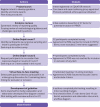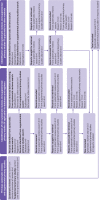Reporting guideline for overviews of reviews of healthcare interventions: development of the PRIOR statement
- PMID: 35944924
- PMCID: PMC9361065
- DOI: 10.1136/bmj-2022-070849
Reporting guideline for overviews of reviews of healthcare interventions: development of the PRIOR statement
Abstract
Objective: To develop a reporting guideline for overviews of reviews of healthcare interventions.
Design: Development of the preferred reporting items for overviews of reviews (PRIOR) statement.
Participants: Core team (seven individuals) led day-to-day operations, and an expert advisory group (three individuals) provided methodological advice. A panel of 100 experts (authors, editors, readers including members of the public or patients) was invited to participate in a modified Delphi exercise. 11 expert panellists (chosen on the basis of expertise, and representing relevant stakeholder groups) were invited to take part in a virtual face-to-face meeting to reach agreement (≥70%) on final checklist items. 21 authors of recently published overviews were invited to pilot test the checklist.
Setting: International consensus.
Intervention: Four stage process established by the EQUATOR Network for developing reporting guidelines in health research: project launch (establish a core team and expert advisory group, register intent), evidence reviews (systematic review of published overviews to describe reporting quality, scoping review of methodological guidance and author reported challenges related to undertaking overviews of reviews), modified Delphi exercise (two online Delphi surveys to reach agreement (≥70%) on relevant reporting items followed by a virtual face-to-face meeting), and development of the reporting guideline.
Results: From the evidence reviews, we drafted an initial list of 47 potentially relevant reporting items. An international group of 52 experts participated in the first Delphi survey (52% participation rate); agreement was reached for inclusion of 43 (91%) items. 44 experts (85% retention rate) completed the second Delphi survey, which included the four items lacking agreement from the first survey and five new items based on respondent comments. During the second round, agreement was not reached for the inclusion or exclusion of the nine remaining items. 19 individuals (6 core team and 3 expert advisory group members, and 10 expert panellists) attended the virtual face-to-face meeting. Among the nine items discussed, high agreement was reached for the inclusion of three and exclusion of six. Six authors participated in pilot testing, resulting in minor wording changes. The final checklist includes 27 main items (with 19 sub-items) across all stages of an overview of reviews.
Conclusions: PRIOR fills an important gap in reporting guidance for overviews of reviews of healthcare interventions. The checklist, along with rationale and example for each item, provides guidance for authors that will facilitate complete and transparent reporting. This will allow readers to assess the methods used in overviews of reviews of healthcare interventions and understand the trustworthiness and applicability of their findings.
© Author(s) (or their employer(s)) 2019. Re-use permitted under CC BY-NC. No commercial re-use. See rights and permissions. Published by BMJ.
Conflict of interest statement
Competing interests: All authors have completed the ICMJE uniform disclosure form at www.icmje.org/disclosure-of-interest/ and declare: no support from any organisation for the submitted work; AG and MG are employees of the Canadian Agency for Drugs and Technologies in Health (CADTH); the current work was unrelated to their employment at CADTH and CADTH had no role in the funding, design, or oversight of the work; ACT is an author of PRISMA 2020 and lead author of the PRISMA extension to scoping reviews; DM is co-lead of PRISMA 2020, coauthor of the PRISMA extension to scoping reviews, corresponding author of the EQUATOR guidance of how to develop reporting guidelines, and chair of the EQUATOR Network; SEB and PW are authors of PRISMA 2020; JEM is co-lead of PRISMA 2020; LH is co-author of the PRISMA extension to scoping reviews; all other authors have no competing interests to disclose.
Figures


Comment in
-
Viewpoints on the PRIOR statement-a reporting guideline for overviews of reviews.Ann Transl Med. 2023 Mar 15;11(5):230. doi: 10.21037/atm-22-5724. Epub 2023 Jan 6. Ann Transl Med. 2023. PMID: 37007563 Free PMC article. No abstract available.
References
MeSH terms
Grants and funding
LinkOut - more resources
Full Text Sources
Medical
Miscellaneous
